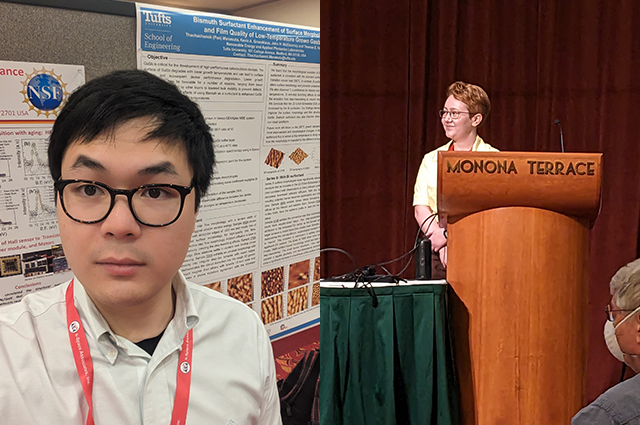Tufts teams present at NAMBE conference

Two Tufts teams from Tufts Renewable Energy and Applied Photonics (REAP) Labs, both advised by Professor and Chair Thomas Vandervelde of the Department of Electrical and Computer Engineering, recently presented at the North American Molecular Beam Epitaxy (NAMBE) conference. Amanda Lemire, a joint PhD student in mechanical engineering and materials science and engineering, delivered a short talk titled “Doping and Surfactant Behavior of Antimony and Gallium in Molecular Beam Epitaxy Grown Germanium-Tin”.
The presentation delved into the effects of doping and the use of surfactants in the growth of germanium-tin (GeSn) materials. The research focused on how the addition of antimony (Sb) and gallium (Ga) influences the surface quality and properties of GeSn films, which can be used in a variety of applications, especially for capturing and emitting infrared (IR) light. By better understanding how these dopants and surfactants affect GeSn growth in terms of surface morphology and reducing defects, the research may lead to more efficient and reliable devices for IR light, which have applications in areas like thermal imaging, optical communication, and energy conversion.
The first author of the research conducted by the second Tufts team was Thachachanok (Pan) Menasuta, a joint PhD student in electrical engineering and materials science and engineering. Menasuta and the team’s poster, titled “Bismuth Surfactant Enhancement of Surface Morphology and Film Quality of Low-Temperature Grown GaSb,” investigated the impact of using a bismuth (Bi) surfactant on the surface morphologies of GaSb (a compound semiconductor) thin films grown at various temperatures.
The results revealed that the addition of Bi as a surfactant significantly improves surface morphology at low growth temperatures, offering potential benefits for enhancing the quality of GaSb films and potentially benefiting other similar III-V semiconductor systems grown under non-ideal conditions. These results are critical for more efficient and reliable mid-IR optoelectronic devices, such as thermal imaging cameras, optical communication components, LEDs, and thermophotovoltaic cells, which all utilize GaSb.
NAMBE, the North American Conference on Molecular Beam Epitaxy, serves as a global platform dedicated to showcasing the latest developments in the field of molecular beam epitaxy, a specialized branch of thin-film materials research pivotal in the realms of semiconductors, lasers, and nanotechnology.